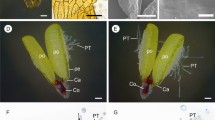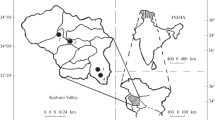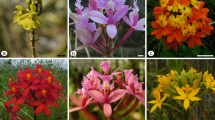Abstract
The structure of the massulae composing the pollinium ofLoroglossum hircinum was studied before pollination and 12 and 24 hours afterwards. The grains are grouped in tetrads closely packed in massulae. The exine is only present on the outside of the massulae. The intine consists of two layers: a compact layer surrounding the pollen grain and a looser layer surrounding the pollen grain and a looser layer surrounding the tetrad. Twelve hours after pollination, pollen volume and the space between the tetrads increase due to vacuolization. Twenty-four hours after pollination, pollen volume and tetrad spacing are higher due to vacuolization and some grains have emitted pollen tubes. Pollen growth due to vacuole formation, and the absence of common walls between adjacent tetrads lead to crumbling of the massulae. The mature pollen grain does not have apertures: the site of pollen tube emission is determined after pollination. The first grains to germinate are those in the centre of the massula. The vegetative cell nucleus is the first to enter the pollen tube; the generative cell elongates and undergoes the second haploid mitosis shortly after entering the pollen tube.
Similar content being viewed by others
References
Brown, R. C., Lemmon, B. E., 1984: Pollen mitosis in the slipper orchidCypripedium fasciculatum. — Sex. Pl. Reprod.7: 87–94.
Burns-Balogh, P., 1983: A theory on the evolution of the exine inOrchidaceae. — Amer. J. Bot.70: 1304–1312.
Clifford, S. G., Owens, S. J., 1988: Post-pollination phenomena and embryo development in theOncidiinae (Orchidaceae). — InCresti, M., Gori, P., Pacini, E., (Eds): Sexual reproduction in higher plants, pp. 407–412. — Berlin: Springer.
Cocucci, A., 1988: Ultrastructural aspects ofEpidendrum male gametogenesis. — InCresti, M., Gori, P., Pacini, E., (Eds): Sexual reproduction in higher plants, pp. 251–256. — Berlin: Springer.
—, 1969: Orchid embryology: pollen tetrads ofEpidendrum scutella in the anther and on stigma. — Planta84: 215–229.
Coleman, A. W., Goff, L. J., 1985: Applications of fluorochromes to pollen biology. 1. Mithramycin-8-4.6-diamino-2Phenylindole (DAPI) as vital stain for quantitation of nuclear DNA. — Stain Technol.60: 145–154.
Dafni, A., 1987: Pollination inOrchis and related genera: evolution from reward to deception. — InArditti, A., (Ed.): Orchid biology: reviews and perspectives4, pp. 80–104. — Ithaca: Comstoch.
Den Nijs, A. P. M., Miotay, P., 1991: Fruit and seed set in the cucumber (Cucumis sativus L.). — Gartenbauwissenschaft56: 46–49.
Fitzgerald, M. A., Calder, D. M., Knox, R. B., 1993: Character states of development and initiation of cohesion between compound pollen grains ofAcacia paradoxa. — Ann. Bot.71: 51–59.
Gerlach, G., Schill, R., 1991: Composition of orchids scents attractingEuglossinae bees. — Bot. Acta104: 379–391.
Heslop-Harrison, J., 1979: An interpretation of the hydrodynamics of pollen. — Amer. J. Bot.66: 737–743.
—, 1987: Pollen germination and pollen-tube growth. — Int. Rev. Cytol.107: 1–78.
—, 1986: The comportment of the vegetative nucleus and generative cell in the pollen and pollen tubes ofHelleborus foetidus L. — Ann. Bot.58: 1–12.
Heslop-Harrison, Y., 1977: The pollen-stigma interaction. Pollen tube penetration inCrocus. — Ann. Bot.41: 221–225.
Hesse, M., 1979: Entwicklungsgeschichte und Ultrastruktur von Pollenkitt und Exine bei nahe verwandten entomo- und anemophilen Angiospermen:Polygonaceae. — Flora168: 548–557.
—, 1983: The fine structure of the pollen wall inStrelitzia reginae (Musaceae). — Pl. Syst. Evol.141: 285–298.
Johri, B. M., Ambegaokar, K. B., Srivastava, P. S., 1992: Comparative embryology of angiosperms. — Berlin: Springer.
Knox, R. B., 1984: The pollen grain. — InJohri, B. M., (Ed.): Embryology of angiosperms, pp. 197–271. — Berlin: Springer.
—, 1986: Structure and function of compound pollen. — InBlackmore, S., Ferguson, I. K., (Eds): Pollen and spores: form and function, pp. 265–285. — London: Academic Press.
Le Deunff, E., Sauton, A., Dumas, C., 1993: Effect of ovular receptivity on seed set and fruit development in cucumber (Cucumis sativus L.). — Sex. Pl. Reprod.6: 139–146.
Lisci, M., Tanda, C., Pacini, E., 1994: Pollination ecophysiology ofMercurialis annua L. (Euphorbiaceae), an anemophilous species flowering all year round. — Ann. Bot.74: 125–135.
Maheshwari, P., 1950: An introduction to the embryology of angiosperms. — New York: McGraw-Hill.
Muller, J., 1979: Form and function in angiosperm pollen. — Ann. Missouri Bot. Gard.66: 593–632.
Nepi, M., Pacini, E., 1993: Pollination, pollen viability and pistil receptivity inCucurbita pepo. — Ann. Bot.72: 527–536.
O'Brien, T. P., McCully, M. E., 1981: The study of plant structure-principles and selected methods. — Melbourne: Termarcarphy Pty.
Ottaviano, E., Mulcahy, D. L., 1989: Genetics of angiosperm pollen. — Adv. Gen.26: 1–64.
Pacini, E., 1994: Cell biology of anther and pollen development. — InWilliams, E. G., Clarke, A. E., Knox, R. B., (Eds): Genetic control of self-incompatibility and reproductive development in flowering plants, pp. 289–308. — Amsterdam: Kluwer.
—, 1993: Role of the tapetum in pollen and spore dispersal. — InHesse, M., Pacini, E., Willemse, M., (Eds): The tapetum: cytology, function, and evolution. — Pl. Syst. Evol., Suppl.7: 1–11.
—, 1978: The reproductive calendar ofLycopersicum peruvianum Mill. — Bull. Soc. Bot. France (Actualités Botaniques)175: 295–299.
Pandolfi, T., Calder, M., Pacini, E., 1993: Ontogenesis of monad pollen inPterostylis plumosa (Orchidaceae, Neottioideae). — Pl. Syst. Evol.186: 175–185.
Pearse, A. G. E., 1968: Histochemistry: theoretical and applied1. — London: Churchill.
Schill, R., Dannenbaum, C., Neyer, P., 1992: Quantitative Untersuchungen an Orchideenpollinien. — Bot. Jahrb. Syst.114: 153–171.
Schlag, M., Hesse, M., 1992: The formation of the generative cell inPolystachia pubescens (Orchidaceae). — Sex. Pl. Reprod.5: 131–137.
Wolter, M., Schill, R., 1985: On acetolysis resistant structures in theOrchidaceae—why fossil record of orchid pollen is so rare. — Grana24: 139–143.
—, 1986: Ontogenie von Pollen, Massulae und Pollinien bei den Orchideen. — Trop. Subtrop. Pflanzenwelt56: 1–93.
Yeung, E. C., 1987: Development of pollen and accessory structures in orchids. — InArditti, J., (Ed.): Orchid biology4, pp. 193–226. — Ithaca: Cornell University Press.
Zavada, M. S., 1983: Comparative morphology and monocot pollen and evolutionary trends of apertures and wall structures. — Bot. Rev.49: 331–379.
Zee, S. Y., Siu, I. H. P., 1990: Studies on the ontogeny of the pollinium of a massulate orchid (Peristylus spiranthes). — Rev. Palaeobot. Palynol.64: 159–164.
Author information
Authors and Affiliations
Rights and permissions
About this article
Cite this article
Pandolfi, T., Pacini, E. The pollinium ofLoroglossum hircinum (Orchidaceae) between pollination and pollen tube emission. Pl Syst Evol 196, 141–151 (1995). https://doi.org/10.1007/BF00982955
Received:
Revised:
Accepted:
Issue Date:
DOI: https://doi.org/10.1007/BF00982955




